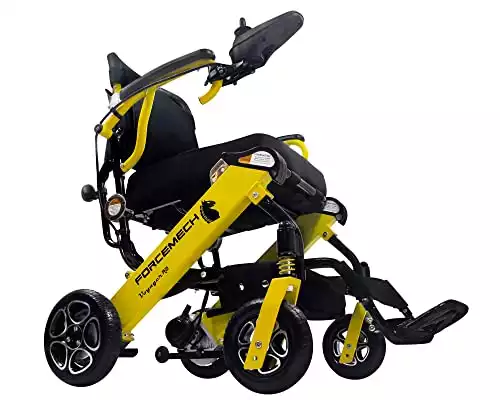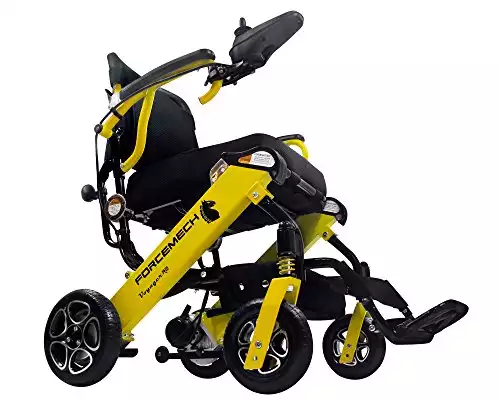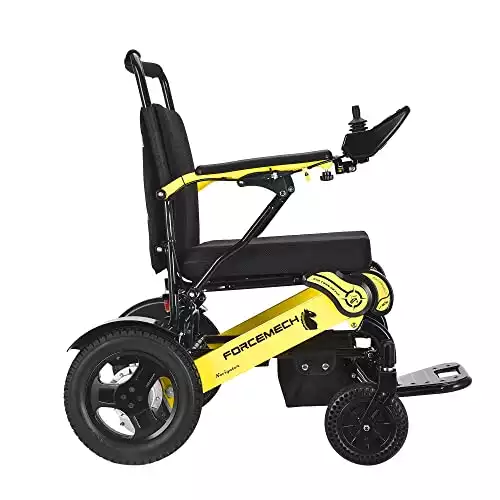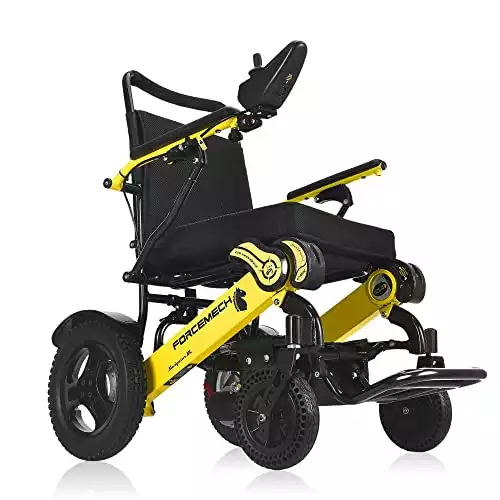Do you have a mobility issue that’s keeping you from enjoying life to its fullest? Have you been scouring the internet looking for reviews and information about the best electric wheelchairs and mobility scooters on the market today, trying to narrow your search?
If you answered yes to either of those questions, then you’re going to enjoy our in-depth brand review of ForceMech power wheelchairs.
Fans of the brand refer to them as the “DeWalt of the Mobility Industry,” owing to the fact that all their models come in the same unmistakable shade of bright yellow, which serves as a nice contrast to the cool-looking black horsehead logo that all their products sport.
Of course, a paint job and a cool logo don’t make a great mobility device, but they sure make ForceMech’s products look distinctive!
We were impressed with the company’s product line, and in the sections that follow, we’ll tell you exactly why. We’ll also tell you about the things that the company doesn’t do a great job at, as some of the shortcomings of the ForceMech power wheelchair lineup might be deal-breakers for you.
Even if that proves to be the case though, we think you’ll agree, that the ForceMech product line is well worth a second, or even a third look as you’re making your decision about which mobility scooter is right for you.
If we’ve piqued your interest with the above, then let’s jump right in and have a look at these rugged, durable machines.
An Overview of the ForceMech Power Wheelchairs
ForceMech makes a total of four different machines, or to be more precise, they make two models, with each model having two variants. We’ll take a closer look at all four machines in the sections below, but before we dive into the particulars, let’s start with a broad overview of all four products in table format.
Forcemech Power Wheelchairs Comparison Table
|
4.6
|
4.7
|
4.7
|
3.9
|
|
4 miles per hour
|
4 miles per hour
|
5 miles per hour
|
5 miles per hour
|
|
12 degrees
|
10 degrees
|
12 degrees
|
12 degrees
|
|
12 miles
|
16 miles
|
16 miles
|
16 miles
|
|
35” x 24” x 37”
|
35” x 23” x 35”
|
38” x 25” x 37”
|
38” x 26” x 37”
|
|
24” x 13” x 31”
|
23” x 13” x 30”
|
25” x 13” x 31”
|
26” x 13” x 31”
|
|
17” x 17”
|
17” x 17”
|
17” x 17”
|
17” x 19”
|
|
19”
|
20"
|
19”
|
19”
|
|
28”
|
30"
|
28”
|
28”
|
|
3.5”
|
3.5”
|
3.7”
|
3.7”
|
|
7” Diameter, 1.25” wide
|
7” Diameter, 1.55” wide
|
7” Diameter, 1.8” wide
|
7” Diameter, 1.8” wide
|
|
8” Diameter, 2” wide
|
9” Diameter, 1.85” wide
|
12.5” Diameter, 2.3” wide
|
12.5” Diameter, 2.3” wide
|
|
33”
|
32”
|
33”
|
33”
|
|
180W
|
200W
|
250W
|
250W
|
|
Detachable omni-directional joystick controller
|
Connected omni-directional joystick controller
|
Detachable omni-directional joystick controller
|
Detachable omni-directional joystick controller
|
|
48 pounds
|
47 pounds
|
59 pounds
|
60 pounds
|
|
265 pounds
|
265 pounds
|
397 pounds
|
400 pounds
|
Right off the bat then, we see a couple of notable differences.
Max Supported Weight
If you weigh more than 265 pounds, the ForceMech Voyager series isn’t a good fit for you. While the ForceMech Navigator supports a maximum weight of 400 pounds, we’re not sure why the Navigator XL winds up with three extra pounds of supported weight – it’s such a scant difference it seems like it must be a typo. Until we hear back from the company on the matter, we’re leaving the information as we found it on the company’s website.

Power
All four models utilize the same basic brushless DC electric motor, although as you see indicated in the chart, the power output varies quite considerably. They also use the same super lithium-ion battery packs, and all four models utilize the same “intelligent” electromagnetic braking system, so where handling is concerned, they’re all very similar.
In terms of total power, Navigator provides more of a “get up and go” factor and is 1 MPH faster than its smaller cousin, Voyager. But if portability is your main concern, then Voyager wins the day, having both a (slightly) smaller footprint and a lighter overall weight.
Controller Type
One point of curiosity for us was why the ForceMech Voyager R2 is the only model in the company’s lineup that doesn’t offer a detachable controller. The R2 is ostensibly the more advanced product compared to the base model, Voyager. So we can’t fathom why the company decided to give the R2 a fixed controller, which reduces its versatility, but the company has remained silent on that point so far.
Portability and Footprint
The Voyager models aren’t any heavier than many conventional wheelchairs, which makes them super convenient. While if you opt for either of the Navigator models, they’re heavy enough that a person with a mobility issue may have some difficulty loading and unloading the scooter into a transport vehicle, solo.
Even so, when folded, all four machines present a reasonably small footprint, and you’ll find no difficulty storing them in a full-sized SUV or truck, and most hatchbacks will accept them without difficulty. If you have a mid-sized sedan or smaller, however, storage for transport could pose a problem.
Note: All of ForceMech’s models are constructed using a durable, long-lasting aluminum alloy, and should stand up well to everyday use.
Color
As to the color – as Henry Ford used to say about the Model-T, “you can have it in any color you want, as long as it’s black.” The same thing goes with all of ForceMech’s products, except their chosen color is bright yellow. That’s more than just a marketing gimmick though. The company says they choose the color because it’s easy to spot in the dark, making it a small safety innovation that’s worth noting.
With the basics out of the way then, let’s dig a little deeper than the chart and see what each of the four models has to offer beyond raw specs here in our ForceMech brand review.
Comfort
All four of ForceMech’s scooters are reasonably comfortable but note that none of them has a headrest, which could make long-duration sitting a problem. Of the four, only the ForceMech Navigator XL has anything resembling a headrest, and in its case, all you get is a padded “roll bar” where your head would rest, which isn’t the most comfortable option.
Since there’s no headrest, there’s no way you can buy extra padding for it. Though in theory, you could get creative and do a bit of DIY modification and rig something up that might serve as an acceptable headrest.

Even then though, if you’ve got to spend most of each day in the scooter, this one is going to leave you wanting. It’s great for short- to medium-duration sitting, to a maximum of about 5-6 hours at a stretch, but after that, the lack of a headrest is going to make it increasingly uncomfortable.
In terms of general comfort, the seats and seat backs of all four models aren’t bad, and certainly more comfortable than your average wheelchair. Then again, if you plan on being in the thing for extended periods of time, then the addition of aftermarket cushions for the seat and seat back will be a good investment.
Adjustability
Both the armrests and the footrests of all four models can be height adjusted, which gives you a great deal of latitude in terms of configuring your chair to provide a better “fit” for you individually, which translates into a more comfortable ride. Note that none of the seats on any of Forcemech’s models recline. They are in a fixed position, set to a 105-degree angle.
On-Board Storage & Extras
All four of Forcemech’s scooters come with a built-in safety belt and a convenient storage basket designed to fit under the seat.

We love the under-seat storage because it’s convenient for the person sitting on the scooter and easy to get to. In fact, we wish all companies would make under-seat storage a standard feature, but alas, most don’t, so kudos to Forcemech for giving us a generous amount of storage space, just where we like to see it!
Another thing that’s worth a special mention here relates to batteries.
If you’ve read our Roundup Review of the Best Wheelchairs for the Elderly you may remember that we called special attention to the fact that Forcemech scooters can go up to 25 miles on a single battery charge, which may make you wonder why the numbers listed in the chart above are far less than that.
There’s a delightfully simple explanation: The figures above reflect the travel range using a single battery, but all of Forcemech’s products were designed such they can hold two batteries. If you opt to purchase a second battery for your scooter, you can safely double the range figures in the chart above. Note, however, that the default configuration of Forcemech’s products will see them delivered with but a single battery, so if you want the extended range, you’ll have to buy your second battery separately.
Great Handling Indoors and Out
One of the things you’ll be pleasantly surprised at is how well all four of ForceMech’s models handle various terrains. The joystick controller is intuitive and easy to master, and even on the smallest, lightest model (the base model Voyager), the motor is powerful enough to get you over a wide range of terrain.
We will note, however, that if you plan on using your scooter mostly outdoors, you might want to look more closely at the ForceMech Navigator models because they’ve got larger rear wheels and offer more raw power, both key to getting over more challenging terrains.
Lest we oversell it, it’s important to note that although ForceMech’s scooters are rugged and durable, and the Navigators are especially adept at handling outdoor terrains, these aren’t ATVs.
While the ability to handle a twelve-degree slope is nothing to scoff at (that’s the maximum recommended slope for three of ForceMech’s four models, as noted in the table above), these scooters do have their limits. Take on a too-challenging terrain, and you’ll find yourself in need of a rescue, so start modestly and be sure help is nearby if you’re experimenting on the terrain you haven’t used the scooter on before.

All four models have a very similar turning radius, with the Voyager R2 turning one inch tighter (32”) than the others (33”). Even so, sometimes small differences make all the difference, so consider carefully how you plan on using the scooter, and whether or not that one-inch smaller turn radius is important to you because it might be!
A good rule of thumb is this: The Voyager products are, on balance, better for mostly indoor terrains, and the two Navigator models are more adept at handling outdoor terrains, while still being a breeze to use indoors.
A Slight Learning Curve, Minimal Assembly Required
Assembly-wise, about the only thing you’ll have to do when your ForceMech arrives, is to mount the controller, although if you buy the Voyager R2, you won’t even have to do that.

If you do have to mount the controller, you’ll be done in less than five minutes. From there, simply drop the battery into place (or batteries, if you’ve bought a second) and you’re ready for your first ride.
There is a slight learning curve, and you’ll want to spend at least a few minutes getting the hang of the joystick controller and familiarizing yourself with how the machine handles (this is true regardless of which model you choose to purchase).
A good general guideline is: If you’ve ever played a video game, plan on spending about five minutes mastering the controls. If you haven’t, plan on spending ten to fifteen minutes. That’s it. It won’t take most people much longer than that to feel comfortable driving the scooter around.
Pros & Cons of ForceMech Power Wheelchairs
As you can see, there’s a lot to like about ForceMech’s products. In fact, other than mentioning that you may want to buy an aftermarket seat cushion, we haven’t had the first negative thing to say, which may lead you to wonder what the catch is.

Well, here’s where we’ll be giving you the bad news. Although ForceMech gets all the big stuff right, it’s the details that tend to trip them up, and details matter.
In no particular order, here are some of the things you may not like about ForceMech’s products:
Individually, none of these things are deal breakers, and even collectively, you might not find them a big deal, but some people will, and we wanted to be sure to mention the various shortcomings, so you’d have all the information you need in order to make an informed purchasing decision.
ForceMech Power Wheelchair Reviews Conclusion
We love the ForceMech power wheelchair lineup! For us, the things the company struggles with are entirely forgivable and relatively easy to work around. While it’s true that we’d rather not have to rig fixes on an expensive product, we’re “Do It Yourselfers” anyway, so that doesn’t give us pause.
We understand, however, that not everyone is going to feel that way, which is why we’ll close by saying that ForceMech makes really good, solid products, but that they fall short of greatness, because of the little things they get wrong.
If, after reading this ForceMech brand review to the end, you find that you’re not bothered by the shortcomings, then we recommend its products (any model) without reservation.
If you’re looking for something with a bit more polish where the details are concerned, some other brand is probably a better “fit” for you.
References & Resources
- Forcemech, Official Brand Website.
- Mobility Scooters Versus Wheelchairs, Disabled-world.
- The Power of Power Wheelchairs: Mobility Choices of Community-dwelling, Older Adults, NCBI.





Hello, I read your review on the ForceMech navigator. Thank you. I am trying to compare it with other HD portable electric wheelchairs. Fold and go (their web sight seams to be down now! Very concerning as it was a company saying it’s employees actually use wheel
chairs! Electra 7HD, Eagle HD (which I read may be by the same manufacture? A name I can not find) Have you reviewed any of these or other light weight portable electric wheelchairs? I could really use your help there doesn’t seam to be any place to go and test out these chairs? Sincerely Anna Marie
Hello Anna Marie, and thanks for your question!
We have not written a review on either the Electra 7HD or the Eagle HD, but we did some research to be able to answer your question completely.
You’re quite right, the Eagle and the Electra appear to be made by the same manufacturer. Of the two, the Eagle HD appears to us to offer the better value and the most bang for the buck.
Comparing them with the ForceMech Navigator, they are highly similar, with the key differences that jumped out at us being as follows:
• The ForceMech chair has slightly larger rear wheels and is probably more capable of handling a broader range of outdoor terrains, although this difference is likely to be nominal.
• The ForceMech Navigator is also significantly faster, boasting a top speed of 5 miles per hour, versus 3.75 for the Eagle and Electra.
If speed and outdoor handling are the things that matter most to you, we’d recommend the Navigator over them.
On the flip side though, as we mentioned in our review, the entire ForceMech product line has some small but non-fatal design flaws that make it somewhat difficult/cumbersome to transport, while the two models you brought to our attention don’t appear to suffer from those shortcomings.
On top of that, ForceMech’s products only come in one color, while you can get the Eagle or the Electra in a variety of colors. That’s a small thing, but if it’s important to you, then that does move the needle in the direction of either of those.
All three chairs have a virtually identical maximum supported weight limit and can handle up to twelve-percent slope grades, but the Eagle and the Electra offer more “extras” (cup holders, oxygen tank holders, and the like), and they have better range and are also marginally lighter, which makes them relatively more comfortable to transport.
Based on all of that, we’d have to give the slight nod to the Eagle HD when choosing between those three products, with better range and ease of transport being the two things that won us over. We’ll put both models on our list to review!